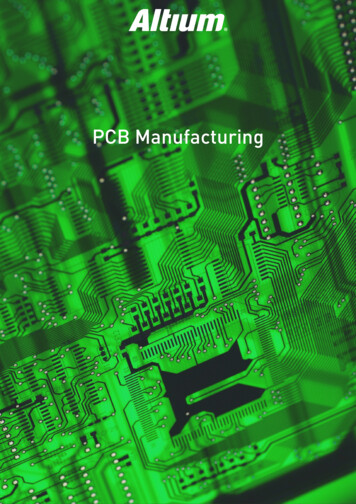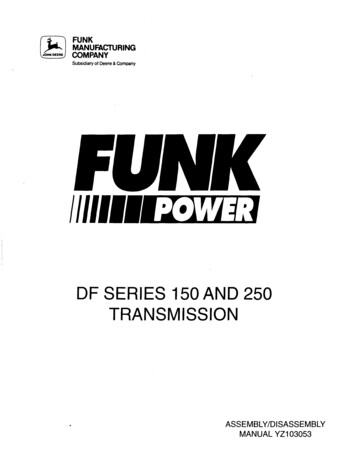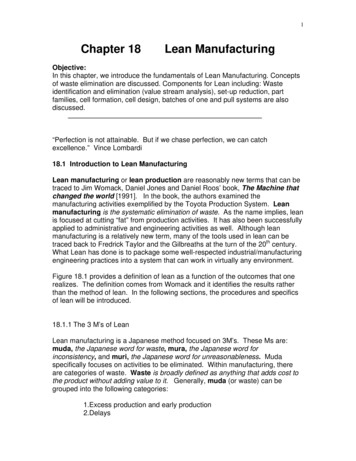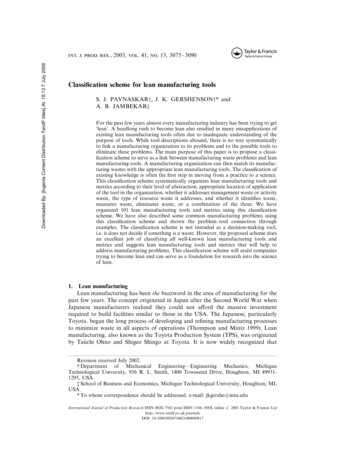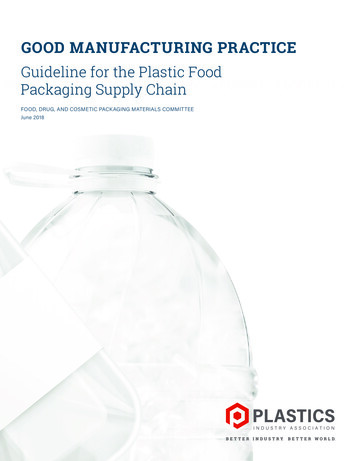
Transcription
GOOD MANUFACTURING PRACTICEGuideline for the Plastic FoodPackaging Supply ChainFOOD, DRUG, AND COSMETIC PACKAGING MATERIALS COMMITTEEJune 2018
GOOD MANUFACTURING PRACTICEGuideline for the Plastic FoodPackaging Supply ChainFOOD, DRUG, AND COSMETIC PACKAGING MATERIALS COMMITTEEJune 2018Plastics Industry Association (PLASTICS)Food, Drug, and Cosmetic Packaging Materials Committeeplasticsindustry.org/projectpass
COPYRIGHT AND DISCLAIMERThis report is copyright 2018, Plastics Industry Association (PLASTICS) Food, Drug, and Cosmetic Packaging MaterialsCommittee. All rights reserved.This publication has been prepared by PLASTICS as a service to the industry. This document is intended for use as a generalreference tool, and is not intended to and does not establish any industry standards or duty of care. Any examples includedin the publication are not intended to be directed to any particular product and should not be considered an appropriatemodel without further considerations to a company’s good manufacturing practice program. This publication is not intendedto provide specific advice, legal or otherwise, on the development of Good Manufacturing Practices and procedures.Readers should consult with their own legal and technical advisors, their suppliers, and other appropriate sources, whichcontain information about known and reasonably foreseeable health and safety risks for their proprietary products andprocesses. Readers are solely responsible for and assume the risk arising from the use of the information provided in thispublication. PLASTICS, its members, contributors, agents, and attorneys make no warranty, express or implied, as to theaccuracy, completeness, or suitability of the information provided herein, and do not assume any responsibility for the user’scompliance with applicable laws and regulations. 2018 Plastics Industry Association (PLASTICS) 1425 K Street, NW, Suite 500 Washington, DC 20005
CONTENTSUMMARY OF CHANGE 1PREAMBLE 2INTRODUCTION 4CATEGORY 1—GMP PLAN 5CATEGORY 2—MANAGEMENT LEADERSHIP AND PERSONNEL 5CATEGORY 3—HYGIENE AND PEST CONTROL 5CATEGORY 4—DOCUMENTATION 5CATEGORY 5—FLOW OF OPERATIONS 5Raw Material Specifications and Acceptance Criteria 5Process and Product Specifications and Evaluation 5Facilities and Equipment 6Laboratories 6ContaminationPrevention 6Packaging and Labeling 6Storage, Warehousing and Transportation 6CATEGORY 6—DEFENSE AND PRODUCT SECURITY 6CATEGORY 7—TRACEABILITY 7CATEGORY 8—INCIDENT AND NON-CONFORMANCE PROTOCOLS 7CATEGORY 9—INTERNAL AND SUPPLIER ASSESSMENTS 7CATEGORY 10—CONTRACTED WORK 7CATEGORY 11—MANAGEMENT OF CHANGE 7GLOSSARY 9SELECTED SOURCES OF INFO ON PLASTICS-RELATED GOOD MANUFACTURING PRACTICE 10
SUMMARY OF CHANGEThe Introduction has been revisedas follows: This GMP Guideline applies to facilities that are notrequired to register with U.S. FDA under Section415 of the Federal Food, Drug, and Cosmetic Act asfacilities that manufacture, process, pack, or hold foodfor human or animal consumption and are thus notsubject to FDA’s Final Rule for Preventive Controls forHuman Food. FDA’s GMP for direct food additives will transferfrom 21 CFR Part 110 to 21 CFR Part 117 upon theeffective dates specified in FDA’s Final Rule forPreventive Controls for Human Food and FDA’s FinalRule: Extension and Clarification of Compliance Datesfor Certain Provisions of Four Implementing Rules.The Glossary has been revisedas follows: The definition of “food” clarifies that 21 CFR Part1.227 excludes food contact substances, definedin Section 409(h)(6) of the Federal Food, Drug, andCosmetic Act as “any substance intended for useas a component of materials used in manufacturing,packing, packaging, transporting, or holding food ifsuch use is not intended to have any technical effect1PLASTICS Good Manufacturing Practice Guidelinesin such food.”The Selected Sources section hasbeen updated as follows: The following note has been added for the reader:“The URLs below were active and correct as ofpublication of this version of the Guideline. Theyare subject to change or break, however, and linkeddocuments may not necessarily be the latest editionsof the sources cited. Please take care to verify.” Broken URLs were replaced, and references tooutdated documents were deleted and/or updated tothe latest versions. A link was added to FDA’s “Draft Guidance forIndustry: Questions and Answers Regarding FoodFacility Registration” (Seventh Edition)—Revised The Publically Available Specification (PAS) 220and 223 documents, which informed the originalGuideline published in 2012, have been replacedby the Technical Specifications ISO/TS 22002–1and ISO/TS 22002–4, the latter for food packaging.Once ISO published the requirements as “TechnicalSpecification” (TS), they were benchmarked forFSSC. These are available at the following tml All references to FDA’s Food and Cosmetic SecurityPreventive Measures Guidance have been removed,because this Guidance has been replaced by FDA’sFinal Rule for Mitigation Strategies to Protect FoodAgainst Intentional Adulteration, which explicitlyexempts food-contact substances from its scope.
PREAMBLEThis guideline for the plastics industry was prepared by representatives ofnumerous PLASTICS member companies which, themselves, comprisenumerous links in the plastic food, drug, and cosmetic packaging materialsmanufacturing supply chain.The document is intended as a guide to assistemployees whose responsibilities include assuranceof their companies’ adherence to appropriate GoodManufacturing Practices (GMP). It is intended to serveas a general reference tool for companies and facilitiesthroughout the plastic packaging supply chain, fromresin manufacturer through packaging converter.This document does not establish a GMP program thatwould be appropriate for any particular facility. Rather,this document serves as a guide for topics and areasthat should be considered during development of a GMPprogram for facilities not required to register with U.S.FDA under the Food Safety Modernization Act (FSMA)and thus not subject to FDA’s Final Rule for PreventiveControls for Human Food. Any GMP program must betailored to a specific facility, its manufacturing conditions,the nature of the product being manufactured, and theproduct’s intended use in the packaging supply chain. It ishoped that the concepts and principles discussed belowwill be a useful tool to assist practitioners with developingan appropriate GMP program for their own facility.PLASTICS Good Manufacturing Practice Guidelines2
3PLASTICS Good Manufacturing Practice Guidelines
INTRODUCTIONThe concept of good manufacturing practice (GMP) underpinsthe manufacture of all products regulated by the Food and DrugAdministration (FDA).Food and food packaging must be manufacturedunder a GMP program that prevents contaminationand ensures products will be safe. The regulatoryrequirements for a well-designed GMP program vary bythe type of product being produced and by the positionof the product in the manufacturing process and supplychain. GMP must always be considered with regard tothe intended use of the product itself, and it is importantfor all companies that produce food packaging and otherfood contact materials to understand the appropriateGMP for their individual products. Manufacturers offood products have different GMP requirements than acompany that manufactures, for example, a plastic linerthat is used to hold the food product.Likewise, a manufacturer of an additive or resinthat is used in the plastic liner will be subject todifferent GMP than a company converting thosematerials into a finished plastic liner. With regard toregulatory requirements, FDA’s GMP standards forfood contact materials are set forth in Section 174.5of the food additive regulations (21 C.F.R. § 174.5).Section 174.5 simply states the requirement that theregulations for food contact materials are predicatedby the requirements of good manufacturing practice.In comparison to the GMP standards for direct foodadditives (described in 21 C.F.R. Part 117), FDA’sGMP regulations for food packaging provide very littlespecific guidance. The GMP requirements for directfood additives and finished food are not required orappropriate for food contact materials, and FDA has notprescribed the details of appropriate GMP for packagingand other components of food contact materials.From a practical standpoint, GMPs for indirect foodadditives (including packaging) require the use ofsensible measures to assure the products are madeunder conditions that minimize the possibilities ofcontamination that could result in the adulteration offood, and sufficient documentation of these conditions.Such measures also must ensure that the food contactproduct is of a purity suitable for its intended use; underSection 174.5, material that is not of a suitable purityis unacceptable for use in contact with food, even ifthe material otherwise complies with the compositionalrequirements of an applicable food additive regulation.These necessary measures vary depending on thenature of the product and how close it is to the finishedproduct, i.e., whether it is a component of some otherproduct, is subject to further processing and perhapspurification, or is a finished packaging material. Forexample, a manufacturer of calcium carbonate used asa filler in a polymer may focus more on ensuring thepurity of the substance and storing it under appropriateconditions, while a polyethylene terephthalate resinproducer may place more emphasis on compliancewith the applicable specifications described in theregulations and controlling the levels of residualmonomers.Any manufacturer of a product that may become acomponent of food has a general obligation to takeall reasonable steps necessary to minimize potentialimpurities and contaminants in the product, and toinstitute procedures to ensure that the finished productconforms to appropriate specifications. Appropriate caremust be taken to assure GMP compliance. This includesconsidering existing regulatory requirements andindustry standards. This guidance does not supplantthese sources of GMP requirements, but rather providesgeneral principles to assist with implementation.Factors such as technological limitations, the toxicityof the components at issue, and others may alsoaffect development of the GMP program and must beconsidered on an individual basis.4
CATEGORIESCATEGORY 1 Examples may include:GMP PLAN»» specificationsMany of the essential principles of an appropriate GMPprogram are incorporated into effective, accountable,documented management systems under any titleincluding, but not limited to, “GMP.” The design of a GMPprogram can build upon existing quality systems, whichmay be deemed to be sufficient in and of themselves.»» declarations and assurancesCATEGORY 2»» calibration»» product formulations»» batch/lot records»» process parameters»» control procedures»» test methods and analytical recordsMANAGEMENT LEADERSHIP AND PERSONNEL»» standard operating proceduresManagement should provide appropriate resources forqualified supervisory and involved personnel to performGMP activities related to finished articles, intermediatematerials and food contact substances:»» management of change Management responsibilities for GMP implementationshould be assigned, defined and documented. Personnel should be adequately trained in a mannerthat they can understand, observe, and implement therequirements of a company’s GMP plan.CATEGORY 3HYGIENE AND PEST CONTROL Hygiene measures, as appropriate to the processand/or position in the supply chain, should beimplemented, maintained, and documented forpersonnel, factories, warehouses, and transportationvehicles/vessels/containers. Pest control measures should be maintained anddocumented as appropriate to the manufacturingprocess and/or position in the supply chain. Careshould be taken that the pest control measuresemployed are appropriate for use in proximity to foodcontact materials, considering both the impact on foodsafety and the impact on the organoleptic propertiesof the product (e.g., could the pest control measurecreate an unwanted taste or odor problem).CATEGORY 4DOCUMENTATION GMP documents referenced in other sections of thisGMP Guideline should be retained and periodicallyreviewed and updated per individual company policy.Companies should ensure that they are complyingwith applicable record retention policies.5PLASTICS Good Manufacturing Practice Guidelines»» maintenance/cleaning protocols»» non-conformance investigationsCATEGORY 5FLOW OF OPERATIONSRaw Material Specifications and Acceptance Criteria Specifications should be established, reviewed andre-validated on a regular basis, as deemed appropriate. Companies should consider a process to specify andapprove raw materials based on their conformity withapplicable regulations and rules of suitable purity fortheir intended use. A process should be determined for approvingsuppliers of raw materials. A process should be considered to verify rawmaterials’ conformance, and to identify and controlnon-conformant materials. Resulting documentation—including, for example,supplier declarations and assurances—should bemaintained and reviewed as deemed appropriate.Process and Product Specifications and Evaluation Specifications should be established, reviewed andre-validated on a regular basis, as deemed appropriate. Procedures should be available to manufacturingpersonnel so that they may be checked to avoid deviations. Procedures to verify manufacturing processconformance with applicable specifications, andto identify and control non-conformant processparameters should be documented.
Procedures should address internally generated andrecycled materials, as appropriateFacilities and Equipment Control systems to prevent cross-contaminationamong raw materials, work in process, auxiliarymaterials, maintenance and cleaning supplies,finished products, etc., as appropriateConsideration should be given to the processes usedto design, install and maintain facilities and equipmentfor purposes of protecting product integrity and purity.Some examples may include but are not limited to: Procedures to control contamination during materialshandling, transfer, packaging and loading operations Water of suitable quality Processes should be considered to specify andapprove product packaging materials in accordancewith applicable industry and authoritative standards. Ice, water backflow prevention Wastewater management Ancillary materials (e.g., machine lubricants, processlubricants, other processing aids) Ingress and egress to the facility, with respect tohygiene and securityThe following examples may apply to open processesand not to closed processes:Packaging and Labeling Companies should adopt procedures to ensure allmaterials are properly and clearly identified andlabeled, as appropriate. Examples may includeancillary materials, finished products, work inprogress, recycled materials, and in-use chemicals. Containers should be properly closed and adequatelysecured to prevent contamination. Lighting (e.g., shatterproof or guarded/ shielded)Storage, Warehousing and Transportation Facilities’ condition (e.g., holes in walls, roofs,exterior grounds) Equipment used for storage and transportation ofmaterials should be designed to facilitate sanitationand pest control operations. Employee facilities (e.g., personal storage lockers,cafeteria/break room, restrooms, hand washing facilities)Laboratories Storage facilities and transportation services shouldprotect the quality of materials (e.g., environmentalcontrols, cross contamination, and off-odors prevention).Internal and external laboratories should possess thequalifications and capabilities deemed necessary toprovide accurate and reliable results. Laboratories shouldhave processes in place to ensure the proper handling ofsamples and results. Procedures should be put into place to minimize,identify, and mitigate damage and contamination tocontainers and their contents.Contamination PreventionCATEGORY 6Processes should be in place to identify, assess, andcontrol critical hazards, if any, that might otherwiseresult in contamination of products by unwantedbiological, chemical, and/or physical agents.Considerations include: Equipment and set up procedures to controlcross-contamination Procedures to control cross-contamination whentransitioning from one product to another Inventory rotation practices should be designed asappropriate (e.g., obsolescence, first in first out).DEFENSE AND PRODUCT SECURITYSecurity measures should be adequate to defendagainst adulteration. Preventive practices, asappropriate, may include the following examples: Operations evaluated; vulnerabilities to tampering andsabotage identified and mitigated Access to facilities limited only to authorizedpersonnel; door keys issued and controlled; employeeand visitor ID badgesPLASTICS Good Manufacturing Practice Guidelines6
Access from facilities’ exterior controlled (e.g., lockeddoors, perimeter fencing, restricted vehicle access,security personnel) Secured incoming and outgoing transportvehicles’ contents Effective electronic information security controlsCATEGORY 7TRACEABILITY Traceability should be established throughout themanufacturing process to facilitate necessary actions.A product lot coding scheme is one example of atraceability-facilitating practice. This process should be tested to assess or validate,as appropriate, its accuracy and reliability.CATEGORY 8INCIDENT AND NON-CONFORMANCE PROTOCOLS A system should be established for recording andinvestigating incidents and non-conformances andinitiating appropriate responses, which may includeproduct recovery if needed. Appropriate reactive, corrective and preventiveactions should result from this process. This process should be tested to assess itseffectiveness. The test may include, for example,mock product recovery exercises.7PLASTICS Good Manufacturing Practice GuidelinesCATEGORY 9INTERNAL AND SUPPLIER ASSESSMENTSGMP elements should be subjected to assessments togauge effectiveness. Periodic audits are one optionfor assessment.CATEGORY 10CONTRACTED WORKProviders of contracted services (e.g., toll manufacturingfacilities, storage facilities, sanitation services,transportation services, on-site contractors) should berequired to adhere to applicable practices included inthis GMP guideline.CATEGORY 11MANAGEMENT OF CHANGEAppropriate procedures should be established to guideemployees in the initiation, review, approval and propercommunication (internally and/or externally) of changesthat impact GMP included in this guideline.
PLASTICS Good Manufacturing Practice Guidelines8
GLOSSARYThese definitions do not supersede or replace legal or regulatory definitions.Rather, these definitions reflect the conventional understanding ofpractitioners to whom this document is addressed. Practitioners shouldreference regulatory and guidance documents applicable to their operationswhile considering their customers’ specifications.Good Manufacturing Practice (GMP): those activitiesand procedures which reasonably assure finishedarticles, intermediate materials, or food contactsubstances are produced and controlled to conform withapplicable regulations and standards of suitable purityfor their intended use. This GMP Guideline applies tofacilities that are not required to register under Section415 of the Federal Food, Drug, and Cosmetic Act asfacilities that manufacture, process, pack, or hold foodfor human or animal consumption with U.S. FDA andare thus not subject to FDA’s Final Rule for PreventiveControls for Human Food.Food: that which is intended for consumption byhumans, domesticated pets, and/or livestock. Althoughthe FDA definition of food does include food contactsubstances, facilities must only register with FDA whenthey manufacture, process, pack, or hold food forhuman or animal consumption. This facility registrationrequirement excludes food contact substances, definedin Section 409(h)(6) of the Federal Food, Drug, andCosmetic Act as “any substance intended for use as acomponent of materials used in manufacturing, packing,packaging, transporting, or holding food if such use isnot intended to have any technical effect in such food.”Finished Article: the finished film, bottle, tray, etc.,formed from food contact substances and/or intermediatematerials, in which food is packaged and/or held.Intermediate Material: comprised of one or more foodcontact substances, intermediate material is used to formthe finished article. It is not an intermediate process stepprior to the formation of a food contact substance.Food Contact Substance (FCS): One authoritativedefinition is in Section 409 of the U.S. Federal Food,Drug and Cosmetic Act, which defines an FCS as any9PLASTICS Good Manufacturing Practice Guidelinessubstance that is intended for use as a component ofmaterials used in manufacturing, packing, packaging,transporting, or holding food if such use of the substanceis not intended to have any technical effect in such food.Closed Process: a manufacturing process that is selfcontained and not exposed to the ambient environment.Open Process: a manufacturing process that has oneor more vessels, feeders, or transfer systems that arenot self-contained and therefore exposed to the site’sambient environment.Contamination: the presence of unwanted biological,chemical, or physical agents in finished articles,intermediate materials, or food contact substances.Policy: an overall plan articulating general goals andacceptable procedures.Raw Materials: intentionally added chemicals ormixtures that take part in or are present during theproduction of food contact substances, intermediatematerials, and finished articles.Suitable purity: a determination that byproducts orimpurities are not present at levels that would cause anadverse health, safety and/or organoleptic effect whenthe finished article is used, as intended, in contact withfood. Articles intended for use in contact with food mustbe compositionally compliant with the applicable foodadditive regulations and of a purity suitable for theirintended use.Traceability: the ability to trace the history, application,or location of a food contact substance, intermediatematerial or finished article of interest through production,processing, and distribution, from the supplier (one stepback) to the intended customer (one step forward).
SELECTED SOURCES OF INFO ON PLASTICS-RELATEDGOOD MANUFACTURING PRACTICENOTE: The URLs below were active and correct as of publication of this version of the Guideline. These URLs aresubject to change or break, however, and linked documents may not necessarily be the latest editions of the sourcescited. Please take care to verify.Draft Guidance for Industry: Questions and AnswersRegarding Food Facility Registration (SeventhEdition)—Revised U.S. Food and Drug Administration(December mConsolidated Standards for Inspection: Food ContactPackaging Manufacturing FacilitiesAIB International (October d-Contact-Packaging-Manufacturing-FacilitiesGlobal Standard for Packaging and Packaging MaterialsBritish Retail Consortium (July standards/packaging/FSSC22000 Food Safety System Certification version 4.1Foundation FSSC22000 (December downloads.xml?lang enCommission Regulation (EC) 2023/2006 of 22December 2006 on good manufacturing practice formaterials and articles intended to come into contactwith food, Official Journal of the European Union, L384,29-12-2006, UriServ.do?uri ulatoryInformation/Milk/UCM513508.pdfGood Manufacturing Practices for aluminium alloysemi and end products intended to come into contactwith foodstuffEuropean Aluminium Association (April 2012)www.pac.gr/bcm/uploads/gmp-alum.pdfGood Manufacturing Practice (GMP) Printing Inks forFood Contact MaterialsEuropean Printing Ink Association (March 2016)http://www.eupia.org/uploads/tx edm/2016-03-31EuPIA GMP 4th version final.pdfCode for Good Manufacturing Practices for Flexible andFibre-Based Packaging for Food Flexible PackagingEurope, CITPA (July loads/FPE GMP Code 6.0.pdfGuidelines for Good Manufacturing Practice for PlasticMaterials and Articles Intended for Food ContactApplications Plastics Europe, CEFIC-FCA, andEuropean Plastics Converters (June ntact-applicationsSQF Food Safety Code for Manufacture of FoodPackaging Safe Quality Food Institute (March 2017)http://www.sqfi.com/documents/Grade “A” Pasteurized Milk Ordinance, AppendixJ, Standards for the Fabrication of Single ServiceContainers and/or Closures for Milk and/or MilkProducts (2015 Revision)U.S. Food and Drug uidanceRegulation/PLASTICS Good Manufacturing Practice Guidelines10
1425 K Street NW, Suite 500, Washington, DC 20005P 202.974.5200 plasticsindustry.org
5 PLASTIC oo anufacturin Practice Guidelines CATEGORIES CATEGORY 1 GMP PLAN Many of the essential principles of an appropriate GMP program are incorporated into effective, accountable, documented management systems under any title including, but not limited to, “GMP.” The design of a G


